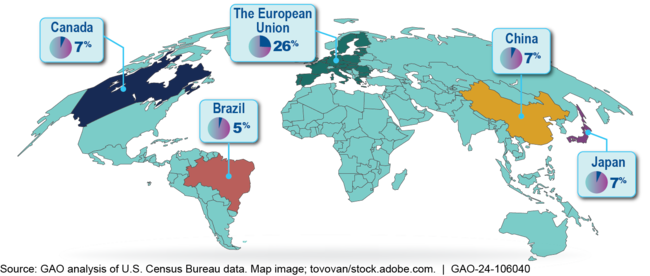Aviation Certification: FAA Should Evaluate Effectiveness of the International Validation Process
Fast Facts
U.S. manufacturers export billions of dollars' worth of airplanes and other aviation products each year. Exported products require safety approvals from both the exporting and the importing country.
Manufacturers told us it's hard to predict how long other countries will take to approve their products. They also said countries are requesting more data and extending timelines, and the Federal Aviation Administration is short-staffed—affecting how much it can help companies.
FAA could find ways to help make safety validations more predictable if it evaluates whether the whole process is effective. We recommended it do so.

Highlights
What GAO Found
U.S. companies export billions of dollars' worth of aviation products, such as airplanes and engines, each year. These products require safety approval from both the Federal Aviation Administration (FAA) and the importing countries' civil aviation authorities (CAA). Bilateral agreements between the U.S. and countries representing the five largest aviation export markets aim to facilitate these approvals through acceptance or validation of each other's product certifications. The approval processes laid out in the implementing procedures for these agreements vary depending on the product's type and complexity. For example, CAA's conduct detailed technical validations for higher risk products with new designs or technologies. These validations can involve extensive review of product designs and other information for the CAA to assess compliance with its own country's regulations and safety and environmental standards.
Five Largest Export Markets for U.S. Aviation Products, 2019-2021

Note: Percentages reflect portion of U.S. total aviation exports. The European Union figure excludes the United Kingdom due to its exit from the European Union in 2020.
The fourteen stakeholders GAO interviewed reported that in recent years, validation time frames have become unpredictable as CAAs have requested more data from aviation manufacturers. Stakeholders cited contributing factors, including CAAs' decreased trust in FAA's certifications after the Boeing 737 MAX 8 accidents in 2018 and 2019. They said that receiving FAA's support—including resolving disputes with other countries' CAAs—can also be challenging due to limited FAA staffing and resources.
FAA recently began collecting and using more detailed information to improve its management of international validations, such as tracking the number of active validations by country. However, FAA has not evaluated the effectiveness of the validations process as a whole. FAA officials said they are beginning to develop an approach for assessing the process, including identifying performance goals and needed data. However, FAA has not yet identified specific steps or a time frame for developing the approach. Assessing the validations process could help FAA identify improvements that might lead to increased predictability in the process and improved accountability to bilateral agreements.
Why GAO Did This Study
For many years, the U.S. has entered into bilateral agreements with certain other countries to facilitate acceptance of each other's certifications of aviation products. However, U.S. companies continue to report experiencing difficulties in obtaining approvals of their products in other countries.
GAO was asked to review the approvals process for U.S. aviation products. This report (1) describes the processes that FAA and CAAs in the most significant export markets for U.S. aviation products use to approve each other's product certifications, (2) examines validation challenges stakeholders identified, and (3) evaluates how FAA ensures that the international validations process is effective. GAO selected five international markets based on the number of validations and reviewed selected bilateral agreements and implementation procedures, FAA data, and FAA's validation policies and guidance. GAO also interviewed 14 aviation industry stakeholders and CAA officials from three countries.
Recommendations
GAO is making four recommendations, including that FAA (1) establish quantifiable goals for the international validations process; (2) identify quality information and performance metrics to track progress towards those goals; (3) use that information to assess results and inform decisions about any needed improvements to the process; and (4) establish a time frame and action plan for these efforts. FAA agreed with the recommendations.
Recommendations for Executive Action
| Agency Affected | Recommendation | Status |
|---|---|---|
| Federal Aviation Administration | The Administrator of FAA should establish quantifiable goals for the international validations process. (Recommendation 1) |
In November 2024, FAA provided GAO with documents demonstrating that it had established two overarching performance goals that are quantifiable for the international validations process: (1) to annually increase the percentage of simpler, 'basic' validations that meet the time frames set forth in the bilateral agreements for the U.S.' largest trading partners, and (2) to annually increase the number of more complex 'non-basic' validations that use work plans. Along with these overarching goals, FAA established performance metrics of 80 percent of basic validations meeting the timeframes specified in bilateral agreements, and 50 percent of non-basic validations using a work plan over the next five years. These goals and performance metrics cover all international validations, and FAA will re-evaluate them when additional data becomes available or when international agreements or validations processes change. By taking these actions, FAA is better positioned to systematically assess the international validations process enabling the agency to make better management decisions related to the validations process and ensure the process is achieving its intended results.
|
| Federal Aviation Administration | The Administrator of FAA should identify the quality information and performance metrics the agency needs to track progress toward the goals it identifies for the international validations process and how it will collect that information, which may include changes to agency data systems or dashboards. (Recommendation 2) |
FAA concurred with this recommendation and has taken some actions to implement it. In 2024, FAA began standardizing the information it collects about inbound and outbound international validations, including information on the type of validation, the involved Foreign Civil Aviation Authority, the dates of key actions and their disposition, the use of work plans, and the ultimate approval of the validation. To do this FAA developed new job aids for FAA staff to use when inputting information on both inbound and outbound international validations into FAA's Work Tracking System and published a memo describing how FAA staff should follow the job aids. FAA is using the information collected through this process to populate dashboards that show the number of validations by status, type and country. In addition, in January 2025 FAA said that it is conducting a review of the data it collects and considering areas to expand metric collection for certain validations as well as to identify additional areas for improvement in data tracking, reporting, and performance evaluation. FAA said that it plans to complete this evaluation by the end of Fiscal Year 2025. While these actions demonstrate progress towards implementing this recommendation, FAA is not using these processes to collect information on outbound validations from Boeing, the largest U.S. aerospace manufacturer. For Boeing validations, FAA is continuing to use a separate system that does not integrate with its Work Tracking System. In February 2025, FAA indicated that it is working to develop a new platform for the Work Tracking System that will allow it to collect information from Boeing and expects to implement this process in Fiscal Year 2026. Until FAA completes its assessment of its data collection practices and begins collecting quality and complete information on all validations in a manner that allows the agency to use the information to inform its decision making about the international validations process, this recommendation will remain open. In June 2025, we contacted FAA for an update and are awaiting a response.
|
| Federal Aviation Administration | The Administrator of FAA should use the information FAA collects to assess the results of and inform decisions about any needed improvements to the international validations process. (Recommendation 3) |
Previously, FAA told us actions for addressing this recommendation are planned further in the future since FAA is not collecting the data we asked them to collect in recommendation 2. In June 2025, we contacted FAA for an update and are awaiting a response.
|
| Federal Aviation Administration | The Administrator of FAA should establish a time frame and develop an action plan for FAA's efforts to develop its approach for assessing the international validations process. (Recommendation 4) |
In January 2025, FAA provided a document describing the actions it has taken so far to develop goals and metrics for the international validations process and to collect information to measure progress towards those goals. However, this document does not contain specific steps for future actions to collect complete, quality information about all international validations, and does not specify how FAA will use that information to assess the results of the validations process and inform decision making on any needed improvements. In June 2025, we contacted FAA for an update and are awaiting a response.
|
